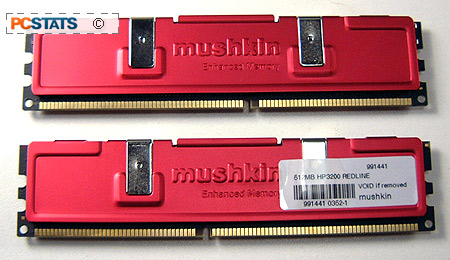Overclocking has become big business, and every day
more people are joining the ranks. Manufacturers and resellers have recognized this
fact, which is why you see enthusiast friendly gear all over the
place.
While the prices of mainstream & value oriented memory have been
falling fast, high speed & low latency memory is still expensive because
demand is high. With motherboard manufacturers allowing more voltage
leniency, we're starting to see DDR2 speeds from
traditional DDR memory. Top that off
with tight latency timings and you have memory that overclockers will buy, no matter
what the price!
Mushkin is red
hot right now, with
its Redline memory modules gaining an impressive reputation. Today we're going to see how these modules
actually measure up in our tests, and get an idea of how Mushkin is
going to fare in the enthusiast arena.
PCStats will be examining a 1GB dual-channel pack of Mushkin's HP3200 Redline memory (2x 512MB
modules), and we're expecting some impressive results. Each of the
two double-sided 512MB PC3200 DDR DIMMs sports 16 TSOP-II DRAM modules which are cooled
and protected by a sleek red heatspreader. By default, the memory is rated to run
at 200 MHz with 2-3-2-7 memory timings and a voltage of 2.7V. Default voltage is a
bit high, but not out of the ordinary. If you'd like to learn a bit more
about the Mushkin HP3200 Redline memory, check out its specs page.
 |
|
Mushkin HP3200 Redline |
|
|
 | |
Neng Tyi
must be doing well since almost every memory manufacturer is using the company's
heatspreaders... At stock speeds and voltages, heatspreaders are mainly for show
but at high speeds and voltages, they really do seem to make a
difference.
Mushkin
sells it enthusiast memory direct to the public, and its 9.68
lifetime
Reseller Rating should give potential buyers peace of mind. When I go shopping online,
I always check out a store's Reseller Rating, and tend to avoid stores with ratings less
than 9.
PCSTATS Test
Methodology
PCSTATS tests DDR memory
on AMD Athlon64 systems only because Intel is still in the middle of moving its
platforms over to DDR2. Enthusiasts usually keep to the bleeding edge, so fast DDR
memory is useless for the Intel overclocker.
On AMD test systems, we're only interested in seeing how
high we can go with the memory running 1:1, as running with other dividers puts
the overclocking bottleneck elsewhere and not with the system memory. The DDR
RAM latency must run at 2-2-2-5, or the memory's tightest possible timings, as
quick access is more important to the CPU design. Just for arguments sake, we
will also be conducting overclocking tests to see how high the memory will go
with conservative timings (3-3-3-9), although we will only benchmark the system
with the tight memory timings mentioned above. Let's get started!

